The Brazos Performance Preview: AMD E-350 Benchmarked
by Anand Lal Shimpi on November 16, 2010 12:01 AM ESTMemory and Cache Latencies
The Brazos platform was configured with 4GB of DDR3-1066 memory. The IDF system had memory running at DDR3-1333, however AMD had to decrease clocks presumably to meet validation requirements for final silicon. I measured an 86.9ns trip to main memory, a 3 cycle L1 and a ~22 cycle L2 cache. That's a lower latency memory interface than Atom or Core 2 based processors, but a higher latency L2.
CPU Performance: Better than Atom, 90% of K8 but Slower than Pentium DC
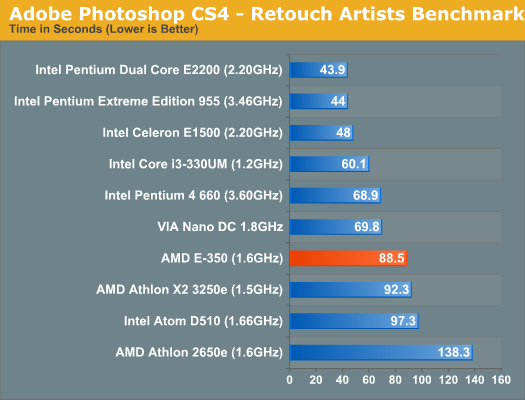
AMD's performance target for Bobcat was 90% of the performance of K8 at the same clock speed and our Photoshop CS4 benchmark shows that AMD can definitely say that it has met that goal. At 1.6GHz the E-350 manages to outperform a pair of K8s running at 1.5GHz in the Athlon X2 3250e. Unfortunately for AMD, Intel's Pentium dual-core running at 2.2GHz is much quicker. Most notebooks in the $400+ range have at least a 2.2GHz Pentium. Even the Atom D510 isn't far behind.
AMD tells me that in general purpose integer tasks, the E-350 should do well and it may even exceed AMD's 90% design target. However in higher IPC workloads, for example many floating point workloads, the E-350 is constrained by its dual issue front end. In these situations, the out of order engine is starved for instructions and much of Bobcat's advantage goes away.

Our x264 HD test has the E-350 performing within 86 - 92% of the Athlon X2 3250e, once again meeting AMD's design targets. Unfortunately, this isn't much faster than an Atom - mostly thanks to Atom's Hyper Threading support. Although not an out of order architecture, Atom gets a healthy efficiency boost by being able to execute instructions from two threads per core. Once again, compared to a 2.2GHz Pentium, the E-350 isn't close. Even VIA's dual core Nano is faster. When it comes to power consumption however, the E-350 can't be touched. I measured max system power consumption at 25.2W while running the x264 encode test. With the exception of the Atom D510, the rest of the desktop platforms here consume much more than that at idle (much less under load).
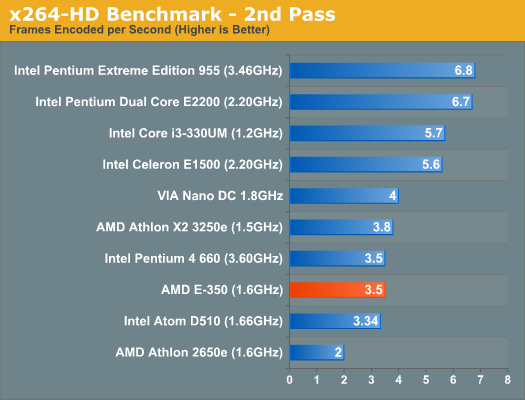
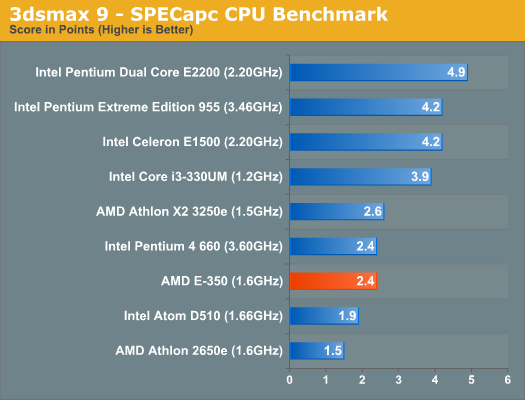
Despite being a offline 3D rendering benchmark, our 3dsmax 9 test does fall in line with expectations. The E-350 delivers 92% of the performance of the Athlon X2 3250e and outperforms the Atom D510 by 26%. Unfortunately for AMD, the Pentium dual-core holds onto a significant performance advantage here. Clock for clock, Bobcat won't be able to do much against anything Core 2 based. The real advantage here will be GPU performance.
Single Threaded Performance
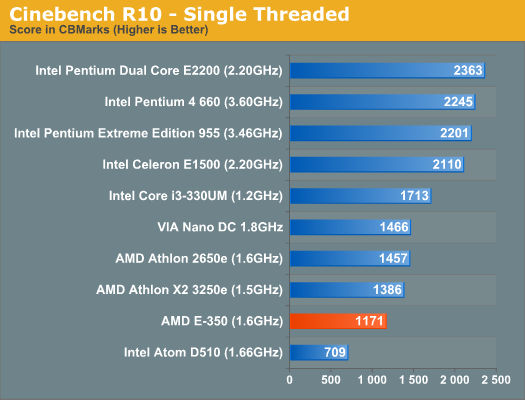
In most of our benchmarks the performance advantage over Atom isn't huge, yet using Brazos is much better than using an Atom based machine. It all boils down to one thing: single threaded performance. Atom can make up for its deficiencies by executing a lot of threads in parallel, but when you're bound by the performance of a single thread the E-350 shines. The E-350 is 65% faster than the Atom D510 in the single threaded Cinebench R10 test. It's this performance advantage that makes the E-350 feel so much quicker than Atom.
The Core i3-330UM manages a 46% performance advantage over the E-350. Even in the ultraportable Arrandale ULV space at lower clocks, AMD still leaves a lot of CPU performance on the table. The advantage here will be cost. A single E-350 is less than 40% of the die area of a Core i3-330UM. You may not get the same CPU performance, but performance per mm^2 is much higher.

In the multithreaded Cinebench test Atom is able to catch up quite a bit, but the E-350 still holds an 11% advantage.
File Compression/Archive Recovery Performance
Our final two CPU tests are both multithreaded and they show the E-350 equaling and falling behind the performance of the 1.5GHz Athlon X2. As we explained earlier, the gap between the E-350 and Atom shrinks as you add more threads to the workload.
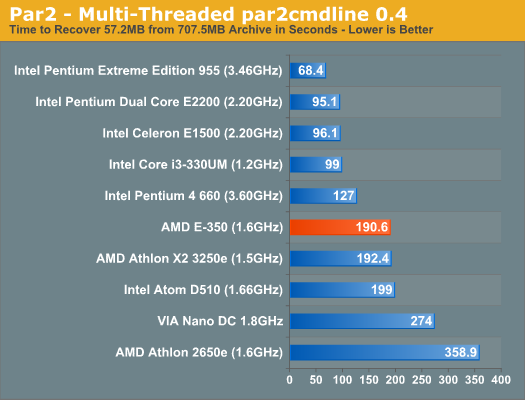
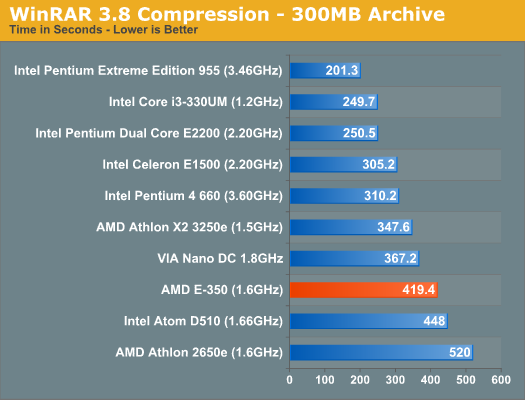










207 Comments
View All Comments
Jamahl - Tuesday, November 16, 2010 - link
Err no.http://hothardware.com/articleimages/Item1589/amd-...
http://www.pcper.com/images/reviews/1039/power-idl...
It will easily outlast atom and beats it in everything.
HelToupee - Tuesday, November 16, 2010 - link
Your graphs show that it eats less power at idle, but when it's actually doing something, Atom burns less. Of course, we're looking at engineering sample quality hardware from AMD, and fully built, tuned systems from Atom. AMD should be able to get those power figures to come down quite a bit.Shadowmaster625 - Tuesday, November 16, 2010 - link
The atom burns less because it doesnt do anything. There is no way to get better power consumption than atom unless you clock the E-350 at 800MHz and hold it there. I suspect that even at that speed, the single core performance would make the system feel faster than the atom, or at least not any slower.Concillian - Tuesday, November 16, 2010 - link
The CPU uses more than an Atom CPU, but the Atom is less integrated and needs more support from the chipset.Arguably idle power is more important than full load power for many applications ideal for the Atom. The only load scenario that really matters much is watching a movie. IN a netbook, idle state is more important. In an integrated system like a kiosk, idle is more important, and Brazos clearly leads in idle.
The power consumption of the entire system at load is not far off from an Atom system at full load. A D525 atom + ION is using more power, but performing worse in all aspects. At this point it comes down to cost as to whether it can compete with an Atom, as it's clear from this article that it doesn't compete well with the "real" CPUs. It has to compete with Atom, because there's no way for it to compete with even CULV Arrandales.
Dark_Archonis - Tuesday, November 16, 2010 - link
So this is the sort of performance that the FASTEST Bobcat product offers? Can't say I'm surprised. In many situations it's barely faster than an Atom D510. I think in some cases an Atom D525 would be faster.Yes, the Brazos E-350 does very well in some games. However, it also does VERY poorly in other games. Compared to AMD's hype, those are terrible performance results for Dragon Age, Starcraft 2, and Civilization 5. Civ 5 and SC2 are both very popular games, so it's not a good sign that Brazos struggles so badly in those games.
I totally agree with the Final Words section and what you say there Anand. So really, the only situations where Brazos makes sense is GPU-dependent applications/games.
A Celeron E absolutely SMOKES Brazos in terms of performance in most situations.
Yes I would say this product is competitive with Intel's offerings, but it is not class-leading. At 18W TDP for a Brazos platform, that is more power intensive than an Atom platform, and almost as power intensive as a Celeron platform. Intel's i3 products also carry 18W TDP ratings.
I agree that the success of Brazos will heavily depend on which OEMs pick up this product, and also how they integrate it.
Once Intel integrates their new Sandy Bridge-level IGP into their low-end products next year, Brazos will look even less appealing.
wiak - Tuesday, November 16, 2010 - link
thats why amd has LIano up it sleevesDark_Archonis - Tuesday, November 16, 2010 - link
Llano will compete with Sandy Bridge though. Do you really think Llano has a chance? It will have a dated Stars CPU combined with a decent Radeon GPU. Yes the GPU might be better than Sandy Bridge's IGP, but by how much?We already know that Llano will lose to Sandy Bridge in CPU performance. It might beat it in GPU performance, but we'll have to see how much of a gap it will be. Also most applications and games are still CPU-dependent. AMD is making a big gamble by having Brazos and Llano be so GPU-dependent.
smookyolo - Tuesday, November 16, 2010 - link
It'll probably beat SB in power consumption, though... D: -quakes in boots-wiak - Tuesday, November 16, 2010 - link
as far as rumors go, LIano has 400 or 480 shader gpu, aka a HD 5670 discrete, in anandtech preview of sandy bridge, its is just as fast as a 80 shader HD 5450add a phenom II based arcitecture then you have a pretty competent mobile gaming system in a mainstream laptop without discrete graphics and way better battery life than with a discrete graphics card
and there is nextgen bulldozer fusion and bobcat fusion still coming
btw, do people even need a high performace CPU in a laptop anyway?, i got a laptop here with Athlon II M320 2ghz with a onboard HD 4250 IGP that decodes blu-ray flawlessly in hardware, plays youtube flash h264 video in hardware, fast enught to work with scanned pictures, digitalcamera pictures etc
and i usely use a quad core gaming rig with a Radeon HD 5870, 4GB memory
Khato - Tuesday, November 16, 2010 - link
As far as rumors go, Llano has at best a 128 bit, DDR3 1600 memory interface, which would give it 25.6GB/s of memory bandwidth available, aka a radeon 5550 with DDR3. Of course it has to share that bandwidth with the CPU, so actually it'll be far less than that. Not to mention, how many manufacturers would actually give it full speed memory?Anyway, I really do quite appreciate the inclusion of the 5450 numbers in this review. It makes it far easier to determine whether the GPU portion is shader or memory bandwidth starved... Though it'd be even better if numbers for an underclocked 5450 were included as well, especially three variations of underclocked (core only, memory only, and then both equal to the 'brazos' tested.) I expect that those numbers would confirm that performance is pretty much memory bandwidth limited. In which case the step from single channel DDR3 1066 at ~8.5GB/s to dual channel DDR3 1600 at ~25.6GB/s would allow for roughly triple the graphics performance.
Oh, and ya know that the Sandybridge preview really isn't at all indicative of actual performance, right? aka, it stands a good chance of matching a memory bandwidth-bound Llano.